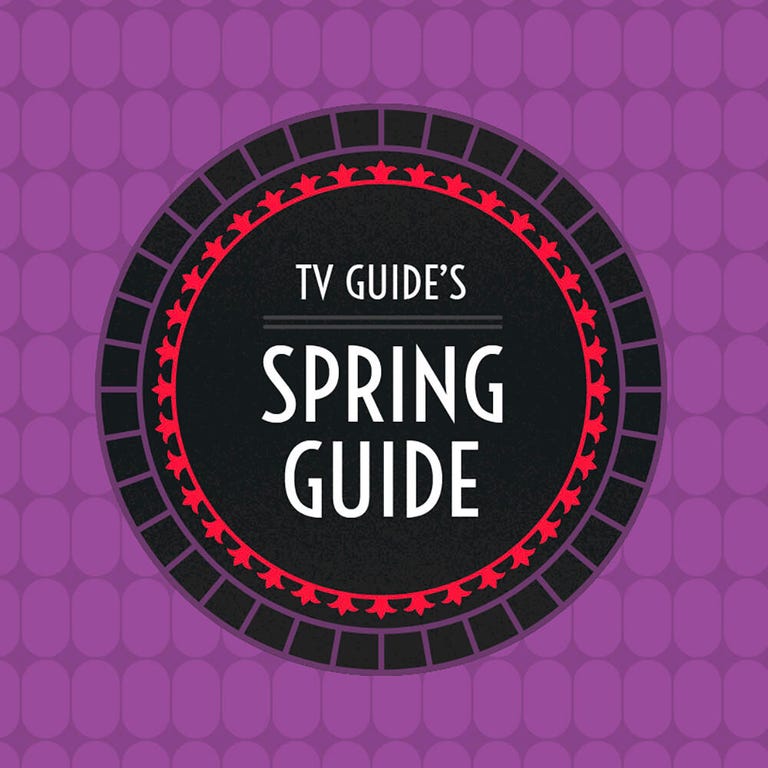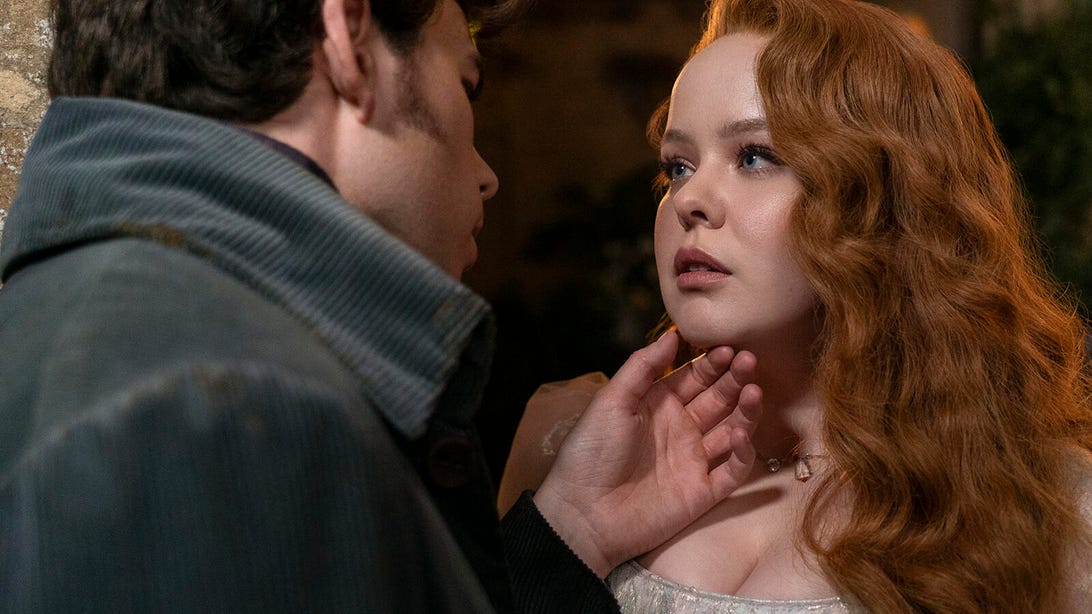Join or Sign In
Sign in to customize your TV listings
By joining TV Guide, you agree to our Terms of Use and acknowledge the data practices in our Privacy Policy.
Bridgerton's Iconic Carriage Scene Makes the Book-to-Screen Adaptation Look Easy
The Netflix series makes just the right changes to bring a memorable scene from the novel to life

Luke Newton and Nicola Coughlan, Bridgerton
Liam Daniel/Netflix[Warning: The following contains spoilers for the first four episodes of Bridgerton Season 3. Read at your own risk!]
Well, we have to talk about the carriage scene, don't we? Bridgerton Season 3 Part 1 has arrived, and we simply must! talk! about! the carriage scene. There's actually so much we could dive into in regards to our Regency-era romance show's excellent third outing, but since it was announced that Bridgerton would buck the book order trend and use Season 3 to tell Penelope (Nicola Coughlan) and Colin's (Luke Newton) love story — based on the fourth book in Julia Quinn's Bridgerton novel series, Romancing Mister Bridgerton — it felt like everyone was waiting with bated breath to see if the iconic carriage scene from the novel would make the cut. Exhale, dearest gentle readers; it arrives in a glorious seven-minute scene to end Episode 4.
This all may sound hyperbolic, but even the team behind Bridgerton knew that there were several scenes from the novel that have become legendary to fans of the book series: When Netflix announced that Season 3 was officially in production back in 2022, they teased us with a cute look at the cast getting ready, ending on our lead, Nicola Coughlan, inviting Luke Newton into a carriage. Oh, they knew exactly what they were doing. There was no way they could tease the carriage like that and not deliver on the carriage. What intense pressure to put on a small but important moment in Colin and Pen's story.

Click through for the latest on spring TV
And yet, was there ever really a worry that they wouldn't get it right? Since Season 1, Bridgerton has been making the book-to-screen adaptation process look easy. There's been much discourse about how the show modernizes the material by way of its diverse casting and storylines to make the series more appealing to viewers — even the anachronistic instrumental versions of contemporary music used as the show's soundtrack make the period drama feel brighter and fresher than most of its genre peers. The series takes place in the early 1800s, and the eight novels were written between 2000 and 2006, which, I'm sorry to be the one to inform you, was around twenty-some years ago. Things have changed! There will always be room and desire for historically accurate period dramas, but there is something to be said for livening things up a bit, for having a little fun; it's obviously worked for the juggernaut that is Bridgerton.
But this author doesn't think that it all comes down to those more superficial changes — we can't overlook the smart choices the creative team (the first two seasons were led by Chris Van Dusen; Season 3's showrunner is Jess Brownell) made when adapting the actual stories and characters for the screen. You simply can't fit everything from a novel into an eight-episode TV show, nor would you want to. Different mediums call for different elements to make them sing. TV moves at a different pace; conflict and character development (especially in a frothy romance) typically need to look different, to have more urgency. The page can be more forgiving than the fast-forward button in that regard.
Take Romancing Mister Bridgerton, for example. Most of the plot of that novel has to do with the mystery of who Lady Whistledown is and Colin's slowly changing feelings for his friend Penelope. I still think one of the smartest things Bridgerton ever did was reveal Whistledown's identity at the end of Season 1 instead of following the book's lead and doing it in Penelope's season. The reveal instantly added layers to the oft-pushed aside wallflower and added some real complexity to literally any of her scenes with the people she cared about; look at how it's paying off in Season 3 with both Eloise (Claudia Jessie) and Colin. It also removed the "who" part of that looming mystery from the board, both making way for the more interesting "When will people find out she's been lying?" mystery and adding so much more room for relationship drama (the real reason we've come to this particular party, be for real).
More on Bridgerton:
- What's next for Bridgerton's troubled best friends Penelope and Eloise?
- Bridgerton's showrunner goes inside the carriage scene
- More shows like Bridgerton to watch next
- Everything to know about Bridgerton Season 3
- Bridgerton: What to remember before watching Season 3
Like this change, so many others have only added urgency to the plot and agency to our players — especially our heroines. The plot in Season 3 looks almost nothing like Pen and Colin's book, and it's a much stronger season of television for it. With the season split into two parts, each block of four episodes needs its own arc: a conflict and resolution, a build and a release. It's Storytelling 101. This first swath of episodes does that so well by making the central plot more of a Pygmalion story, with Colin agreeing to help his friend find a husband before falling for her himself, adding that dynamic onto the friends-to-lovers trope. In the book, we can spend time in the characters' thoughts as they contemplate their changing feelings. On screen, we need more action, and this gets us there — not to mention the changes it helps facilitate in Penelope as a character. In the novel, she can feel so pathetic (in the novel, which actually jumps ahead to 1824, she is 28 and makes no moves to find a husband); in the show, when she decides to save herself by getting out of her home and to try to cut off those unhelpful and unrealistic feelings for Colin, she is empowered. It's much more enjoyable to watch her take her fate into her own hands.
And at the same time all of these changes are happening, the foundations of these characters, their relationship, and the book — the reasons we were hyped for a Polin season to begin with — are all still very much there. Which brings us back to the carriage scene. Do you like how I made you wait for it? Everything I know about the benefits of anticipation I learned from watching Bridgerton.

Luke Newton and Nicola Coughlan, Bridgerton
Liam Daniel/NetflixIn the novel, this scene takes place about halfway through the story, when Colin is growing more and more attracted to Pen and has become so obsessed that when he sees her being shady and getting into a carriage going into a strange part of town, he follows her. He confronts her inside a church she ducks into and discovers that she is, in fact, Lady Whistledown. He is full of rage about the secret, about what she's written, and at the idea that he doesn't know her as well as he thought. He has her get into her carriage so he can take her home. They have a huge, pages-long argument about how dangerous this is, how society will cast her out because she's already so different to begin with, which Pen takes to mean ugly (there is so much in the book about Penelope's looks and weight and how Colin is the only one to find her beautiful, and I am thankful every freaking day that the show got rid of all of this — another great, modernizing change!), but he tells her she's beautiful — even though he does basically caveat it with an "I don't know how" and an "I don't know when," which, please, no — and then they go at it. It is spicy, spicy, wonderfully spicy. They wind up at Featherington House, and Colin says his iconic "Are you going to marry me or not?" line.
More on Netflix:
In the TV series, this scene occurs at the end of Episode 4, just as Part 1 is wrapping up, and Colin still has no idea Penelope is Whistledown. Instead, he has realized he is madly in love with her, but she is about to accept a proposal from a very nice suitor, albeit very much a practical match instead of a love match. Colin arrives at the ball where this is about to happen and ruins her one prospect for marriage. Pen runs off to her carriage in tears, and Colin chases her down and begs her to let him in. She yells at him for what he's done, and he finally professes all these feelings he's had for her: this all encompassing, tortuous love. And then things get spicy — so, so spicy. This time, they wind up outside of Bridgerton House, and Colin once again proposes right then and there.
There are so many similar elements to the book here, even though the context has changed, along with many of the motivations on both their parts. The scene on screen gives book fans what they've wanted while enhancing the story. There's one line in this scene that is the perfect example of this: "Oh god, can't we just ask the driver to keep going?" in the book, and "Oh god, can the carriage driver not keep driving?" in the show. In the book, it's Pen who says it, worried that her mother will see her in such a state. She is stressed. In the show, it's Colin who says it, breathless from their activities, in the middle of something not just that he's wanted to do for some time because he's in love, but something really fun. They are enjoying each other, and the laugh they share as he comes up for air is just so Pen and Colin. Part of the reason they are so drawn to each other, the real foundation of their friendship, is how much they make each other laugh: how at ease they are in each other's company. While in the novel, the characters can separately think those things so we're aware of it, it's a small change like this one that reminds a viewing audience of it, too. It gets across so many of the important elements from the source material, but in a way much better suited to this medium.
Page-to-screen adaptations are tricky things. With source material as beloved as the books Bridgerton is pulling from, there is no way everyone is going to be happy — but people need to be realistic about the differences between page and screen. (Listen, you are free to like the book better, if you so choose; I don't know your life!) But it's scenes like the long-awaited carriage scene that really point to the care Bridgerton takes to please book fans while also making the story work for this medium and today's audience. It shouldn't be a surprise that a series boiling over with lavish, extravagant parties knows exactly how to have its cake and eat it too.
Bridgerton Season 3 Part 1 is now streaming on Netflix.